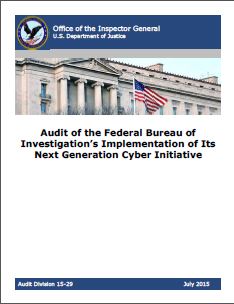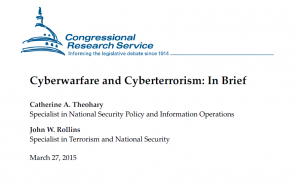While the Congressional Research Service usually provides exceptional reports in the area of cybersecurity (see here, and here), the recent report titled Cyberwarfare and Cyberterrorism: In Brief falls short of the usual level of expertise. The report is full of factual information spanning various topics in cybersecurity, but the facts are thrown together in sections without any clear order or meaning. After reading the summary on the first page, readers are led to believe that the purpose of the report is to set out the legal obstacles standing in the way of clear definitions in cybersecurity. Instead, the report merely lists the various international treaties, processes, conventions and laws relating to cybersecurity. Despite these issues, I will do my best to recap the report below.
Threat Actors and Harms Caused
There are no generally accepted definitions for the various terms frequently used to discuss cybersecurity issues. The report provides some general definitions that have been used for the following terms: cyberterrorists, cyberspies, cyberthieves, cyberwarriors, cyberactivists. For each definition, the authors provide an explanation of the type of harm typically connected to that group of actors. However, the authors also note that the threats posed by these actors and the types of attacks they can pursue are not mutually exclusive.
According to the report, there is no clear criteria for determining whether a cyberattack is criminal, an act of hactivism, terrorism, or a nation-state’s use of force equivalent to an armed attack. As a result, when it comes to defining “cyberwar,” experts are divided over whether to focus on the ends achieved or the means used. The United States recognizes that cyberattacks without kinetic effects are also an element of armed conflict under certain circumstances.
Rules of the Road and Norm-Building in Cyberspace
This section is where the report starts to become disorganized. It starts with a description of two major international processes geared toward developing international expert consensus among international cyber authorities: The Tallinn Manual and Article 5 of the North Atlantic Treaty. The authors then turn to the issues created by the lack of a clear definition of what constitutes an “armed conflict.” Next, the authors provide a brief description of the Council of Europe Convention on Cybercrime, the United Nations General Assembly Resolutions affecting cyber relations, the International Telecommunications Regulations affecting cyber relations, followed by a catch-all paragraph on other international law related to cybersecurity.
The report notes that like “cyberwarfare,” there is no consensus definition of what constitutes “cyberterrorism.” The authors provide descriptions of two laws which provide some clarity on the definition: the USA PATRIOT ACT (18 U.S.C. 2332b) and the Computer Fraud and Abuse Act (18 U.S.C. 1030a-c. According to the report, the issue is that “these provisions are also criminal statutes and generally refer to individuals or organizations rather than state actors.”
Use of the Military: Offensive Cyberspace Operations
In this section, the authors list the various US laws which could potentially be used to authorize offensive cyberspace operations by the military. After listing and defining these laws, one would expect the authors to analyze the ways in which these laws could be applied to offensive cyberspace operations or at least to point out the gaps and ambiguities preventing reliance on these laws for offensive cyberspace operations. However, the authors fail to provide any such analysis and instead conclude this section with a paragraph describing press speculation on a Pentagon plan for Cyber Mission Forces under the Cyber Command.
Conclusion
After reading the final paragraph of the report, I flipped the page over multiple times expecting to find a conclusion section typical in most of the cyber reports from the Congressional Research Service. I was hoping that the conclusion section would provide clarity on the many disconnected facts provided throughout the report. There was no conclusion. Lacking any sort of conclusion, it appears that the authors themselves were unsure of how to tie together the grab bag of information they provided on this very important topic.
To read the full report, click here: Cyberwarfare and Cyberterrorism: In Brief.





Leave a Reply